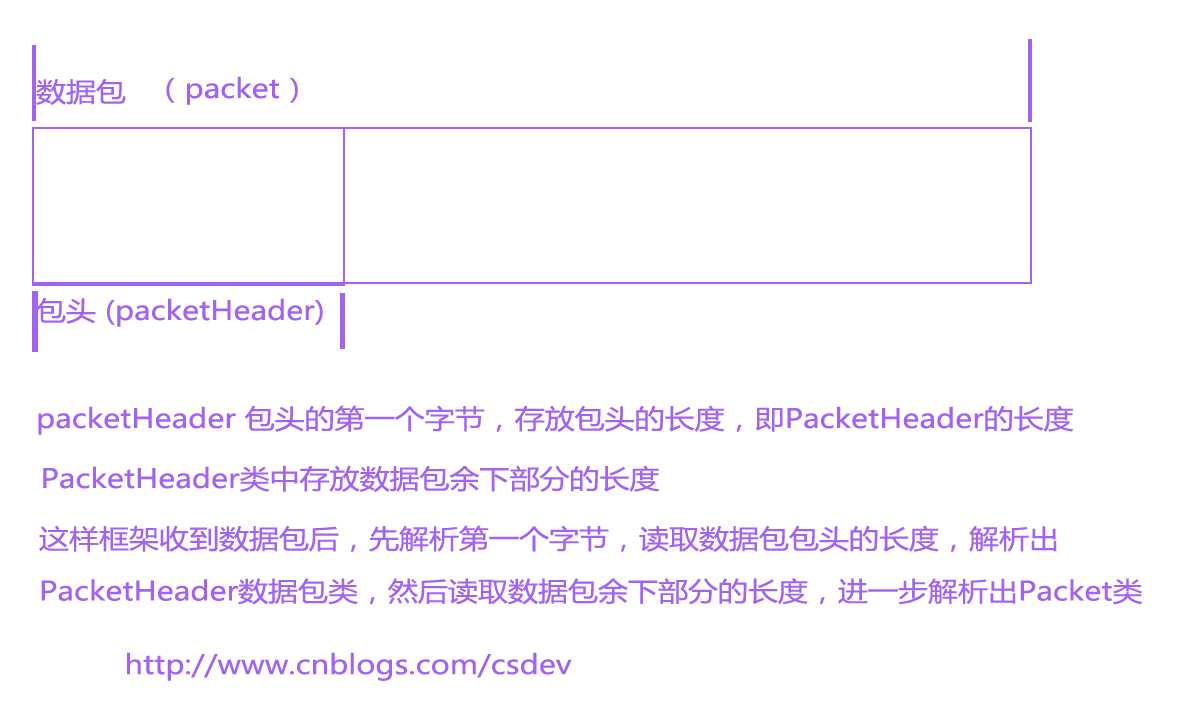标签:
原文网址: http://www.cnblogs.com/csdev
Networkcomms 是一款C# 语言编写的TCP/UDP通信框架 作者是英国人 以前是收费的 目前作者已经开源 许可是:Apache License v2
开源地址是:https://github.com/MarcFletcher/NetworkComms.Net
首先,使用TCP通信的时候存在消息边界的问题,也就是如何处理粘包问题,networkcomms 框架本身已经对这个问题有内置的解决方案,我们在使用框架时直接数据通信即可,不需要关心消息边界问题。
下面我们来分析一下networkcomms对消息边界问题是如何进行处理的。
TCP无保护消息边界的解决
针对这个问题,一般有3种解决方案:
(1)发送固定长度的消息
(2)把消息的尺寸与消息一块发送
(3)使用特殊标记来区分消息间隔
NetworkComms通信框架使用的是第二种 即消息的尺寸与消息一块发送

来看一下这个流程
客户端发送一个类给服务器端
代码如下:
User user1=new User ();
user1.UserID="10000";
user1.Name="天涯共此时";
connection.SendObject("消息类型", user1);
然后networkcomms框架开始发送这个类
在ConnectionSendClose.cs文件中
判断发送的类,是否是Packet类型,如果是使用SendPacket进行发送。如果不是,转换成Packet类型再发送
public void SendObject<sendObjectType>(string sendingPacketType, sendObjectType objectToSend, SendReceiveOptions options, out long packetSequenceNumber) {
//判断发送的类,是否是Packet类型 Packet objectToSendAsPacket = objectToSend as Packet; if (objectToSendAsPacket == null) {
//如果不是,转换成Packet类型再发送 using (Packet sendPacket = new Packet(sendingPacketType, objectToSend, options)) SendPacket<sendObjectType>(sendPacket, out packetSequenceNumber); } else { if (objectToSendAsPacket.PacketHeader.PacketType != sendingPacketType) throw new ArgumentException("Unable to send object of type Packet if the PacketHeader.PacketType and sendingPacketType do not match."); SendPacket<sendObjectType>(objectToSendAsPacket, out packetSequenceNumber); } }
上面的代码中,通过这一句
Packet sendPacket = new Packet(sendingPacketType, objectToSend, options)
把要发送的User类转化为Packet类
来分析一下Packet类
public Packet(string sendingPacketTypeStr, string requestReturnPacketTypeStr, object payloadObject, SendReceiveOptions options) { Constructor(sendingPacketTypeStr, requestReturnPacketTypeStr, payloadObject, options, false); }
要发送的数据类(此次为User类型数据),以参数的形式赋值给Packet.
Packet类,经过一些类内部处理,User类数据,最后经过转化存放在PacketData属性中,也就是包体数据。
Packet类中的SerialiseHeader(SendReceiveOptions options)返回的是包头(PacketHeader)序列化后的数据
Connection类中的SendPacketSpecific方法会先发送包头数据,再发送包体数据。
我们看一下Packet中序列化包头的方法
/// <inheritdoc /> public byte[] SerialiseHeader(SendReceiveOptions options) { if (options == null) throw new ArgumentNullException("options", "Provided SendReceiveOptions cannot be null."); //We need to start of by serialising the header //把包头序列化为二进制数组 byte[] serialisedHeader; using (StreamTools.StreamSendWrapper sendWrapper = options.DataSerializer.SerialiseDataObject(_packetHeader, options.DataProcessors, null)) serialisedHeader = sendWrapper.ThreadSafeStream.ToArray(1); if (serialisedHeader.Length - 1 > byte.MaxValue) throw new SerialisationException("Unable to send packet as header size is larger than Byte.MaxValue. Try reducing the length of provided packetTypeStr or turning off checkSum validation."); //The first byte now specifies the header size (allows for variable header size) //包头转化成的二进制数据,第一个字节的值,设定为包头的长度 serialisedHeader[0] = (byte)(serialisedHeader.Length - 1); if (serialisedHeader == null) throw new SerialisationException("Serialised header bytes should never be null."); return serialisedHeader; }
原文网址: http://www.cnblogs.com/csdev
介绍开源的.net通信框架NetworkComms框架之四 消息边界
标签:
原文地址:http://www.cnblogs.com/csdev/p/5797902.html